Cottage gardens are perfect mixtures of color and form, and they have all of the rustic charm you could want. But if you’re just establishing a new cottage garden, you may not know what plants to choose. To help you out, we’ve compiled this quick guide on the most popular flowers to grow for that classic cottage garden look.

Jump to:
- 19 classic cottage garden plants to grow
- 1. Bigleaf hydrangea (Hydrangea macrophylla)
- 2. Foxglove (Digitalis purpurea)
- 3. Hollyhock (Alcea rosea)
- 4. Delphinium (Delphinium elatum)
- 5. Daisy (Leucanthemum vulgare)
- 6. Roses (Rosa spp.)
- 7. Phlox (Phlox spp.)
- 8. English lavender (Lavandula angustifolia)
- 9. Lupines (Lupinus spp.)
- 10. Peony (Paeonia lactiflora)
- 11. Sweet peas (Lathyrus odoratus)
- 12. Coneflowers (Echinacea spp.)
- 13. Heartsease (Viola tricolor)
- 14. Snapdragons (Antirrhinum majus)
- 15. Columbine (Aquilegia spp.)
- 16. Hardy geranium (Geranium bohemicum)
- 17. Honeysuckle (Lonicera spp.)
- 18. Mock orange (Philadelphus coronarius)
- 19. Lady’s mantle (Alchemilla mollis)
- Summary
19 classic cottage garden plants to grow
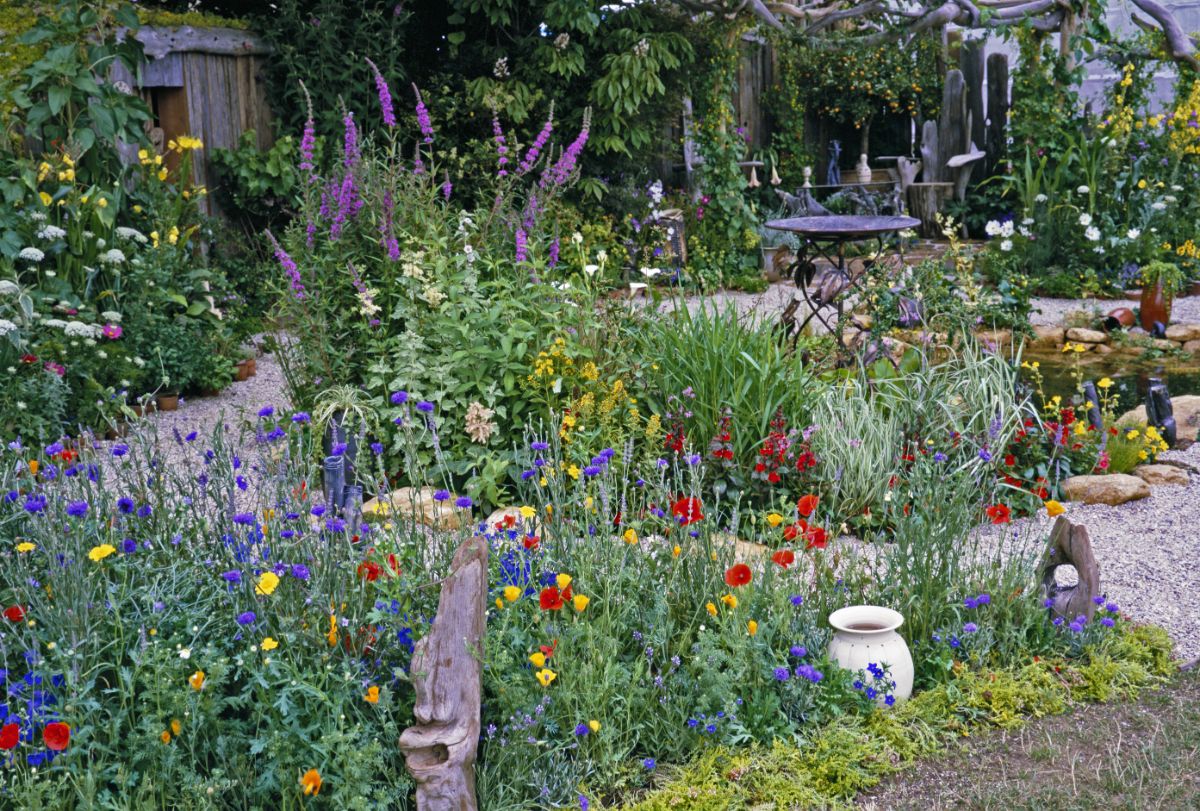
From charming annuals to hardy perennials, there are lots of flowering cottage garden plants to choose from. Here are a few of our favorites!
1. Bigleaf hydrangea (Hydrangea macrophylla)
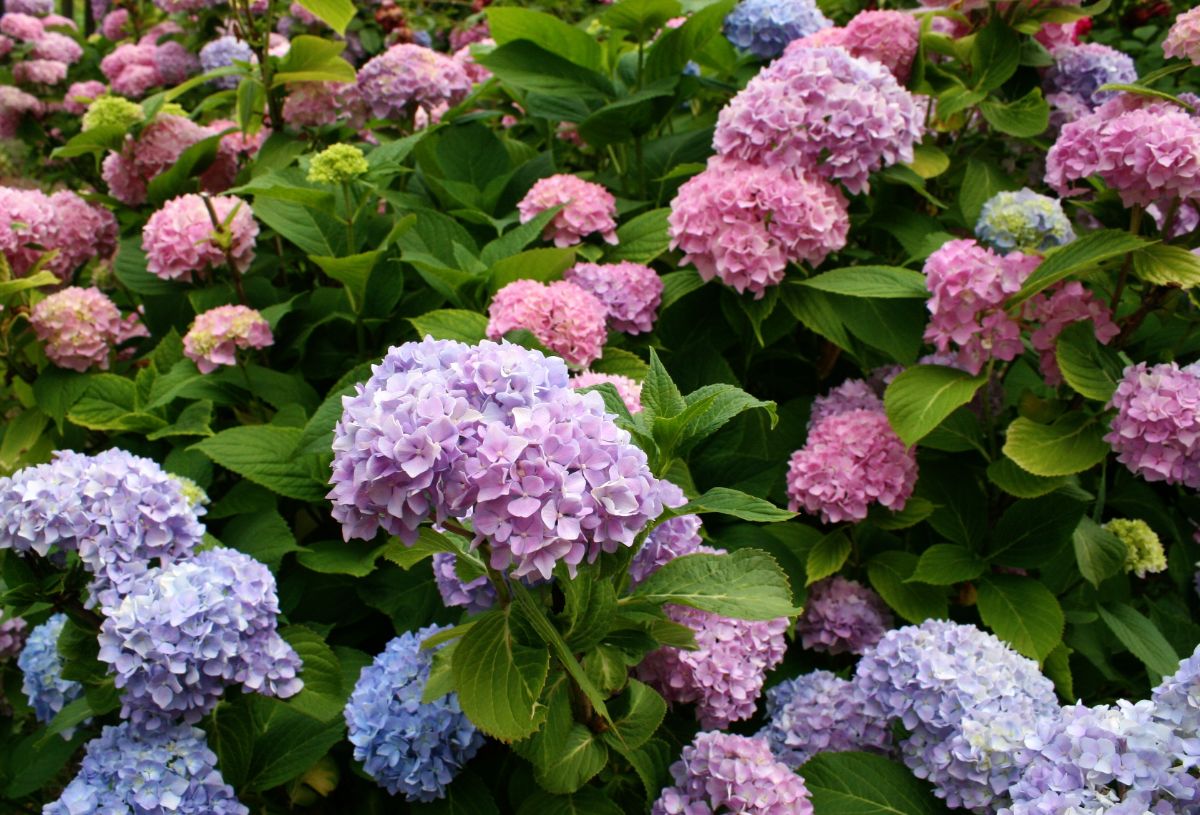
| Plant name: | Bigleaf hydrangea |
| Light requirements: | Full sun to part shade (will benefit from afternoon shade in hot locations) |
| Water requirements: | High to moderate |
| Growing zone: | Zones 5 to 9 |
| Special features: | Garden privacy; Color changing flowers; Flowers dry well |
If you want a plant that makes a huge impact in your garden, hydrangeas are some of the best plants to grow, and they also have that perfect cottage garden feel. There are over 75 different species of hydrangeas, which are mostly native to Asia and the Americas. Bigleaf hydrangeas, however, are one of the best hydrangea varieties for cottage gardens.
Bigleaf hydrangeas have large flowerheads that are usually either mopheads or lacecaps. Both varieties change color when exposed to different soil pH levels, giving you the ability to create a rainbow of flower shades if you want to! For pink-toned hydrangea flowers, raise pH levels by adding lime, or for blue flowers, apply sulfur to acidify your soil.
2. Foxglove (Digitalis purpurea)
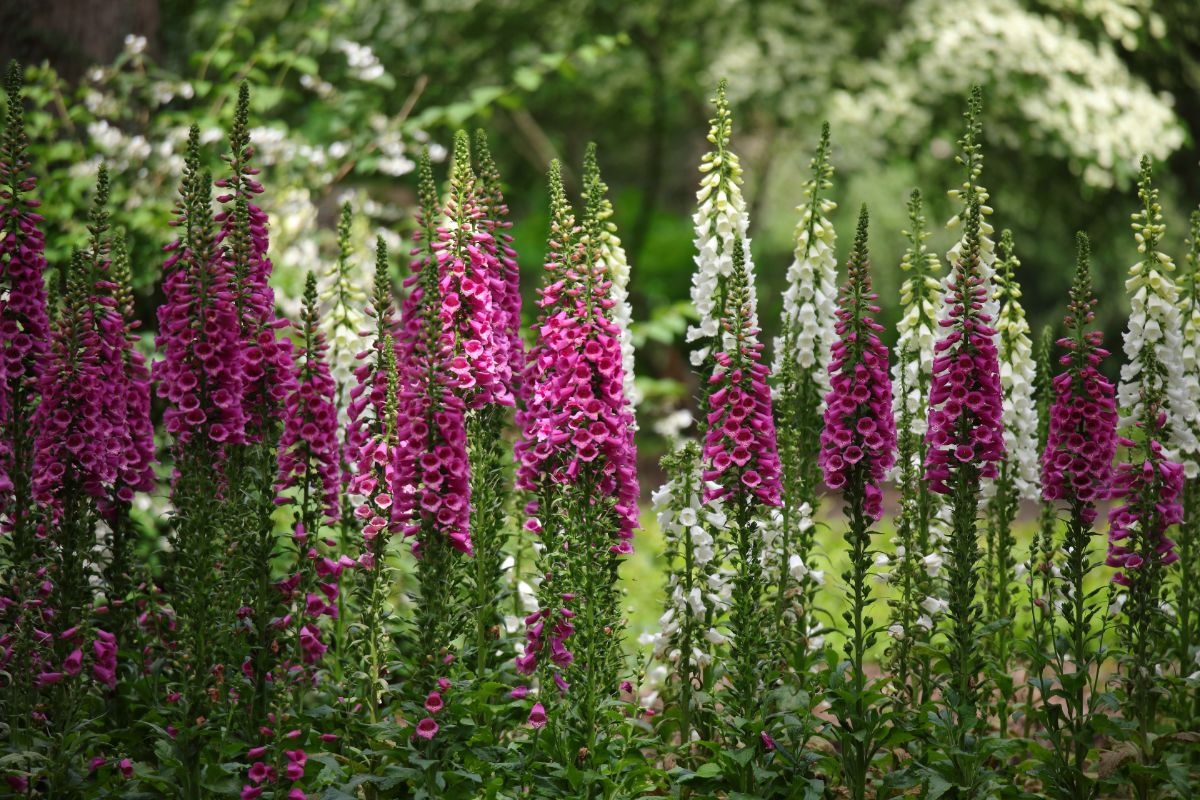
| Plant name: | Foxglove |
| Light requirements: | Full sun to part shade |
| Water requirements: | Moderate |
| Growing zone: | Zones 4 to 9 |
| Special features: | Spring bloomer; Attracts pollinators |
Another top choice for cottage gardens, foxgloves are curious-looking plants with flowers that appear on a sturdy, vertical spire. Flowers are tubular in form and come in pinks, purples, and other charming colors that look just right in cottage gardens. Those flowers are also highly attractive to hummingbirds, so if you want to draw wildlife into your garden, plant some foxgloves!
While foxgloves can grow in full sun, they also do quite well in part shade gardens, which will give you more planting options. For a very whimsical look, try planting foxgloves around a garden fence or walkway or place them in a mixed bed with peonies and other differently shaped blooms. Just keep in mind that foxgloves are toxic, and they shouldn’t be planted anywhere where small children or pets may be able to access them.
3. Hollyhock (Alcea rosea)
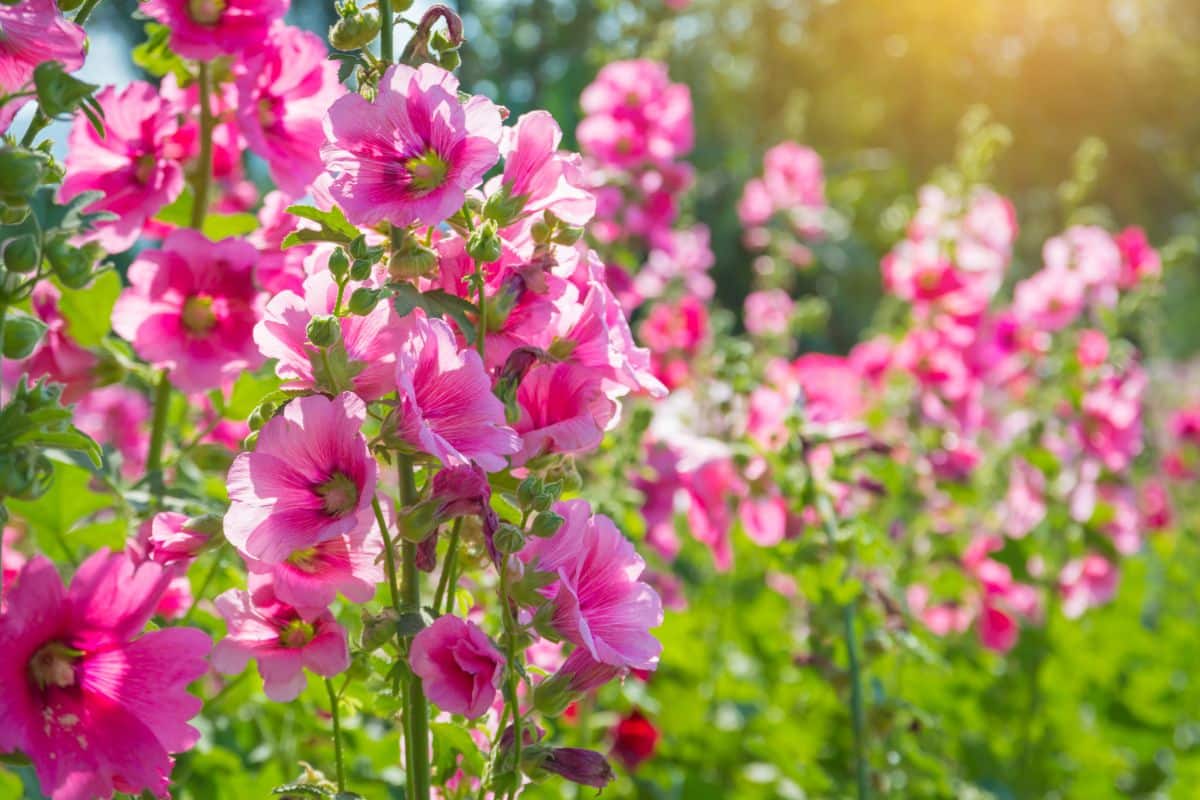
| Plant name: | Hollyhock |
| Light requirements: | Full sun to part shade |
| Water requirements: | Moderate to low (once established) |
| Growing zone: | Zones 3 to 8 |
| Special features: | Great for cut flowers |
Hollyhocks have a rustic and wild look and soft, silky petals that are ideal for cottage gardens. Hollyhocks are tall plants that can grow between 6 and 8’ tall, which makes them a good plant to grow towards the rear of garden beds, where they will form a pretty backdrop to lower-growing foxgloves and coneflowers. Hollyhocks also look striking when planted in a patch on their own, especially if you use hollyhocks with an assortment of flower colors.
Hollyhocks have many different bloom colors, including pink, yellow, and purple. These plants are easy to start from seed; however, since most hollyhocks are biennials, they may not bloom until their second year. In addition to being attractive cottage garden plants, hollyhocks also make wonderful cut flowers as long as you prepare them correctly.
4. Delphinium (Delphinium elatum)
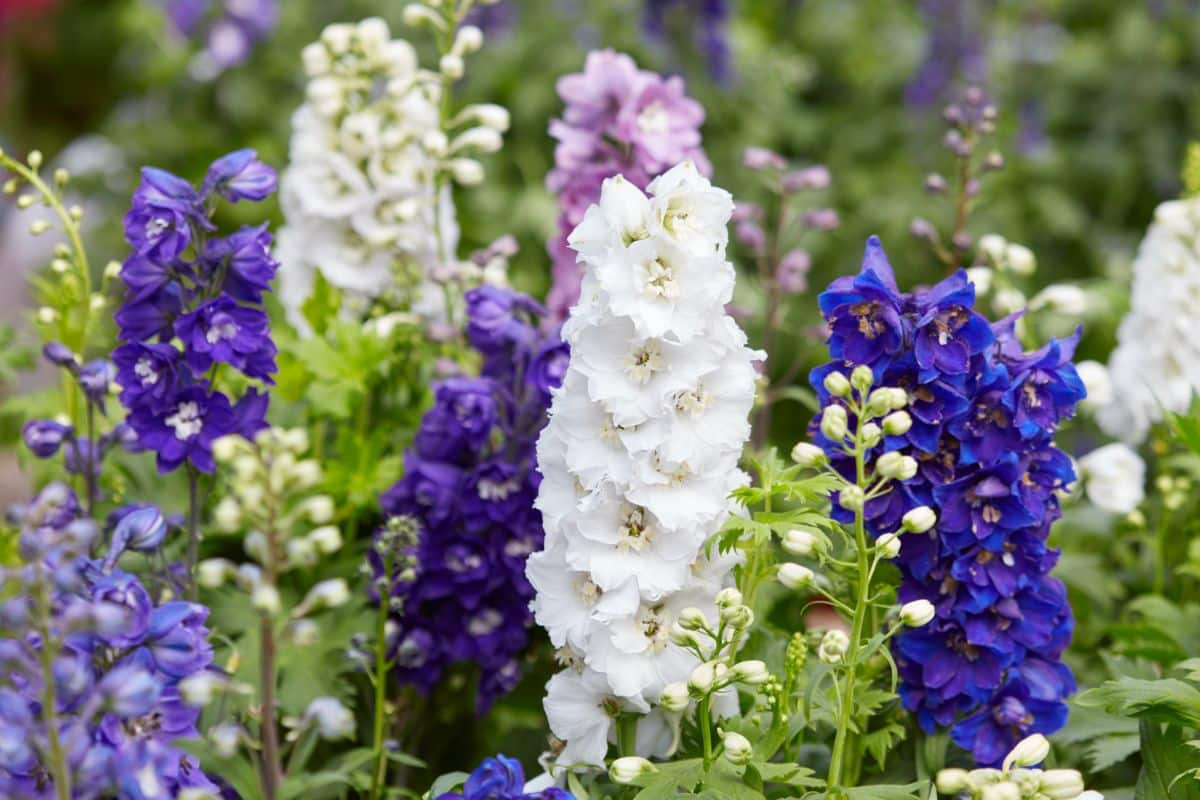
| Plant name: | Delphinium |
| Light requirements: | Full sun |
| Water requirements: | Moderate |
| Growing zone: | Zones 3 to 7 |
| Special features: | Great for cut flowers |
Like foxgloves, delphinium flowers form on tall spires that add vertical interest to garden beds. They are also the perfect size to plant in the middle of mixed gardens, but they are also small enough to grow in containers. Delphinium flowers usually come in a deep shade of indigo blue, but you can also find delphiniums in white, pink, and purple.
Delphiniums are often started from seed, which makes them quite cost-effective to grow but can also plant nursery starts for earlier blooms. Because they grow so tall, delphiniums may benefit from staking, and bamboo poles are an obvious choice for cottage gardens since they’ll blend right in! Full-grown delphiniums usually grow about 4 to 6’ tall, and they make exceptional cut flowers too.
5. Daisy (Leucanthemum vulgare)
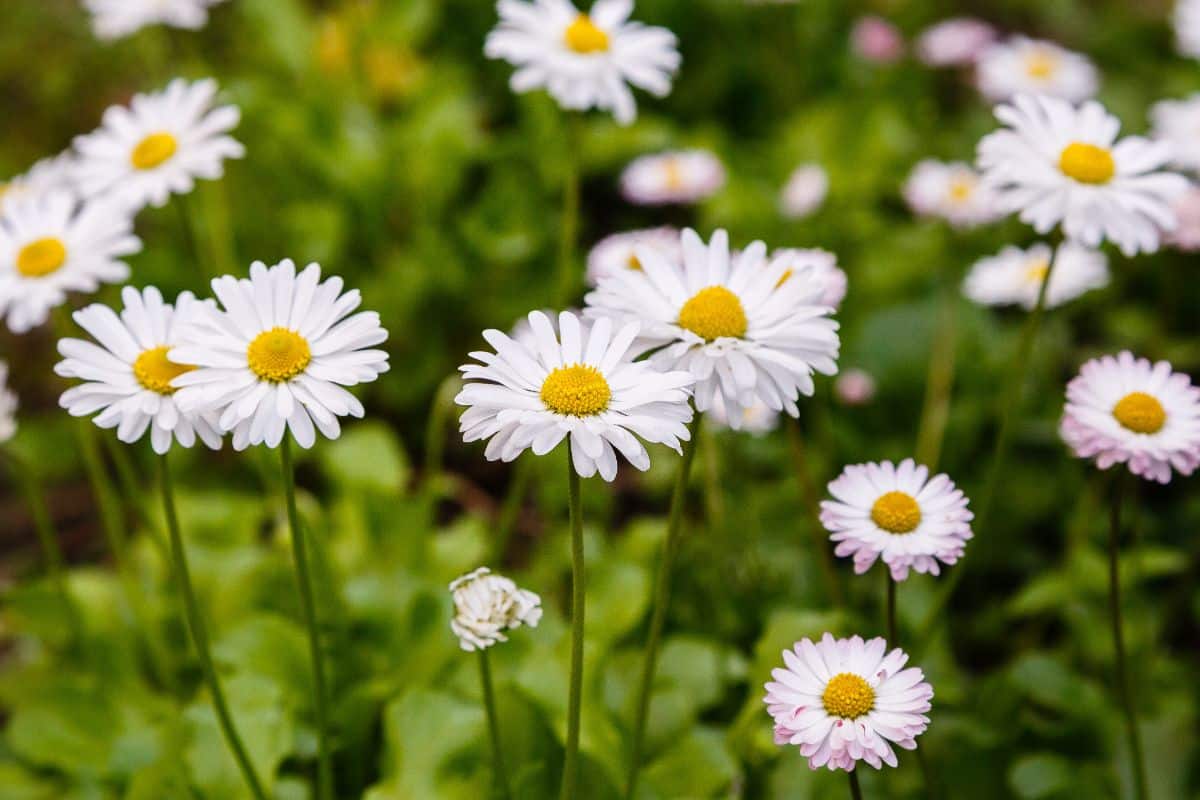
| Plant name: | Daisy |
| Light requirements: | Full sun |
| Water requirements: | Moderate |
| Growing zone: | Zones 5 to 8 |
| Special features: | Great for cut flowers |
Cute as a button, daisies are versatile and hardy little plants that can grow just about anywhere, and no cottage garden would be complete without them! Whether your garden is in full sun or part shade, daisies will grow just fine. However, these plants prefer well-draining soil, and they will grow even better if you mix a bit of compost into your garden before planting.
While white daisies with golden-yellow centers are the most common daisies, you can also find showier varieties with colored petals. Like many other cottage garden plants, daisies can be made into sweet, homemade bouquets, and they also press beautifully for preserved arrangements. And don’t forget, making daisy chains is a favorite summertime craft for kids of all ages!
6. Roses (Rosa spp.)
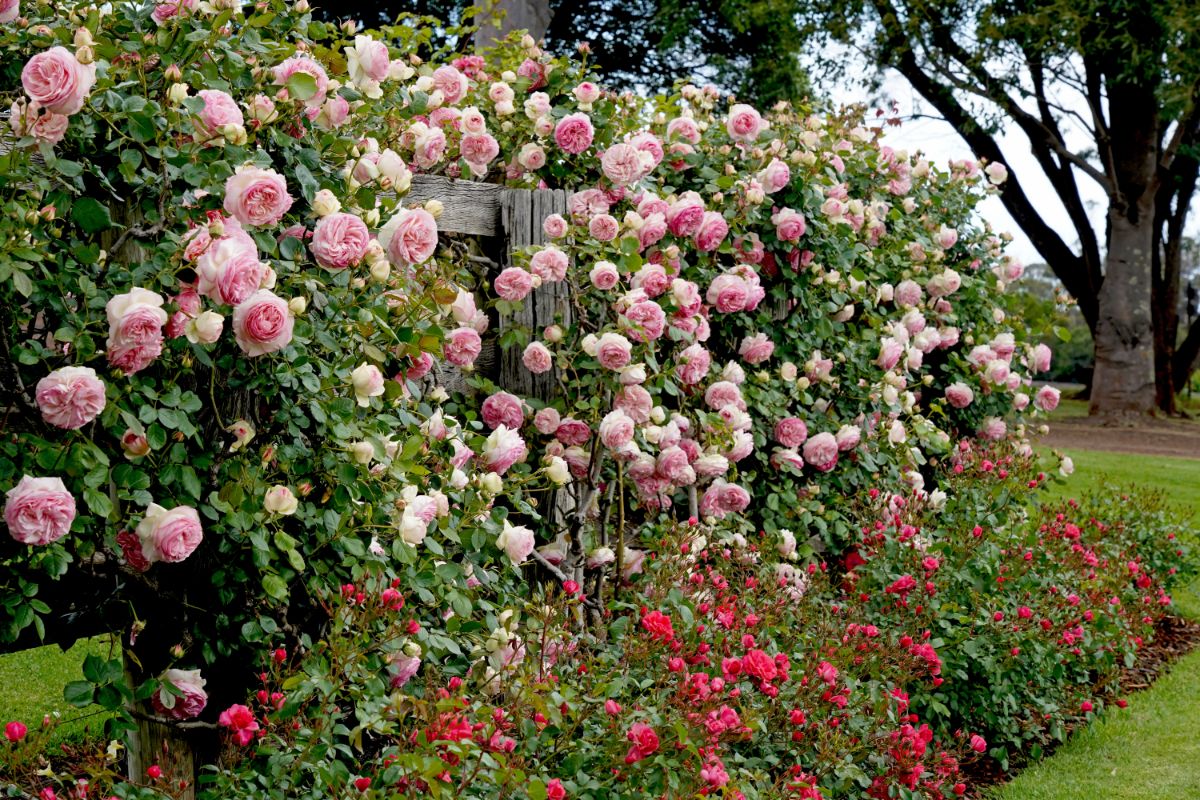
| Plant name: | Roses |
| Light requirements: | Full sun |
| Water requirements: | Moderate |
| Growing zone: | Zones 3 to 10, depending on variety |
| Special features: | Great for cut flowers; Climbing varieties add vertical interest; Scented varieties are highly fragrant |
Roses come in all shapes and sizes, flower colors, and fragrance intensities. For cottage gardens, climbing roses are an obvious choice that will add beauty and grace when trained to grow over garden archways, fencing, and more. You can also plant roses in inground beds or keep smaller varieties in containers; it’s up to you!
Not all roses carry a fragrance, so if a scent is important to you, check out English roses or other heirloom rose types. Some roses also make better-cut flowers than others, but no matter what rose you grow, these plants will reward you with an impressive display of colorful petals. And if you want to add edibles to your cottage garden, many roses have edible rosehips that are tasty when brewed into homemade jams, jellies, and tea.
7. Phlox (Phlox spp.)
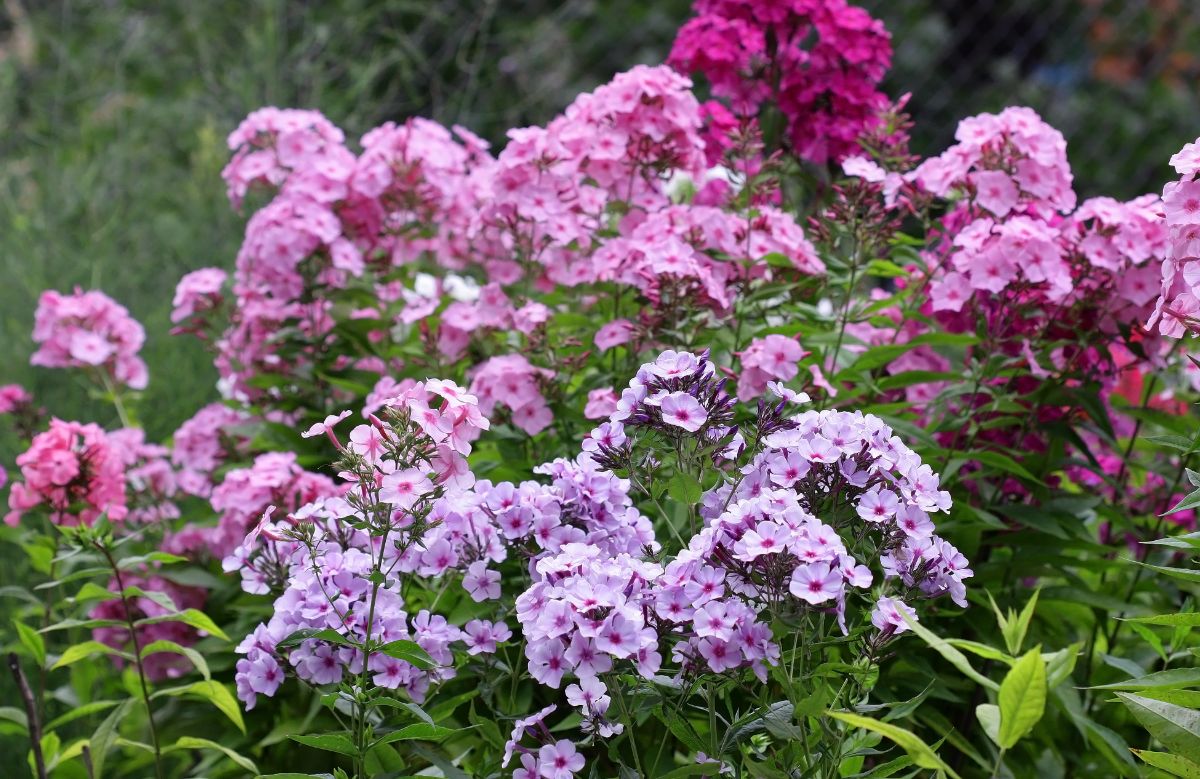
| Plant name: | Phlox |
| Light requirements: | Full sun |
| Water requirements: | Moderate |
| Growing zone: | Zones 4 to 8 |
| Special features: | Fragrant flowers; Spring blooming varieties; Attracts pollinators |
There are 67 different types of phlox plants, including some perennial and annual species. However, two of the most common phlox varieties to keep in cottage gardens are tall phlox and creeping phlox. Both of these phlox types offer something unique to garden designs, and they can be planted together for even more garden color.
Creeping phlox blooms earlier in the season and can be used as a colorful groundcover that will form a thick carpet of pink and white when it blooms from April to May. Tall phlox flowers emerge later in the season and are highly fragrant. Both phlox types are a hit with bees and pollinators, and lighter-colored flowers show well after dark for evening enjoyment.
8. English lavender (Lavandula angustifolia)
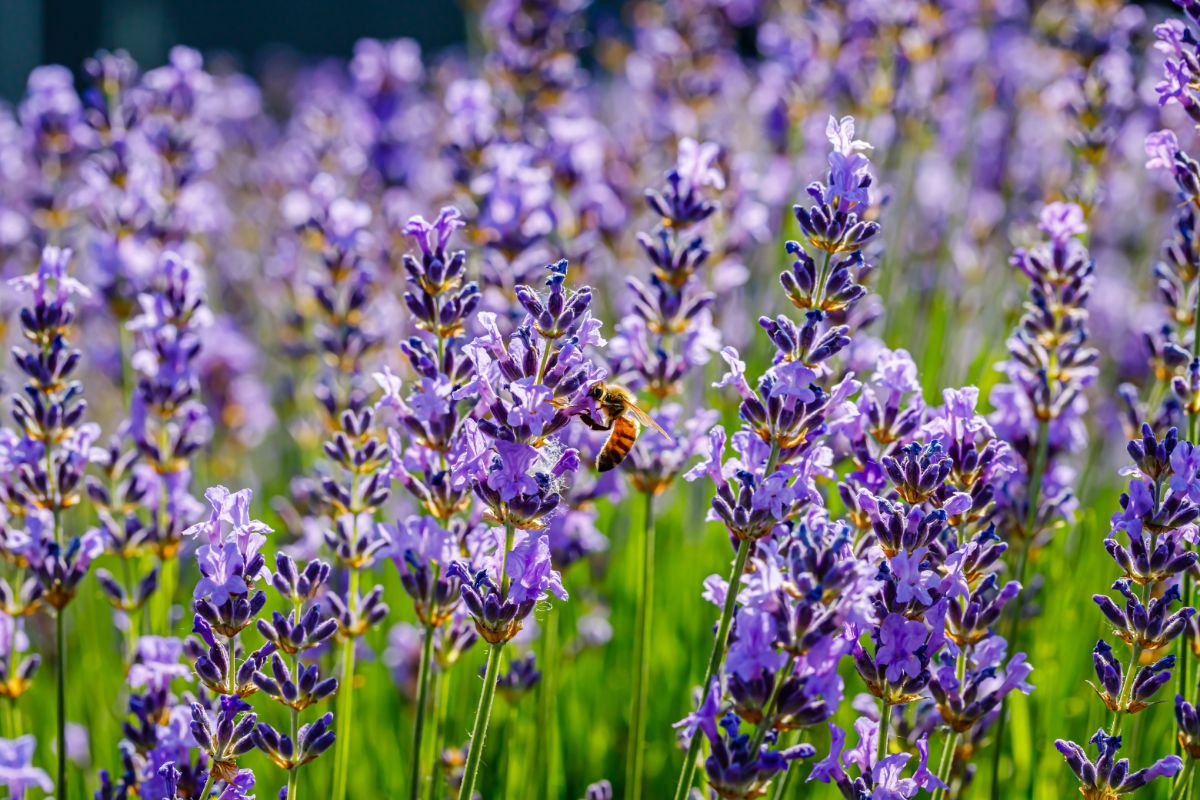
| Plant name: | English lavender |
| Light requirements: | Full sun |
| Water requirements: | Low |
| Growing zone: | Zones 5 to 10 |
| Special features: | Fragrant; Attracts pollinators; Edible; Good for crafting; Good for containers |
Consider English lavender an essential plant to grow in cottage gardens because these plants just have so much to offer! Lavender flowers are a brilliant purple color that will complement many other cottage garden picks, like peonies and roses. But the plant’s foliage is also an attractive silvery green, which can add texture to garden beds even when the lavender isn’t in flower.
Of course, the primary reason why most gardeners grow lavender is that the plant produces a strong fragrance, which can lend a magical and transportive feel to garden spaces. Lavender can also be used for crafting, and English lavender is edible and delicious in teas and desserts. These plants don’t like soggy soil though, so always plant them in well-draining earth and don’t overwater them!
9. Lupines (Lupinus spp.)
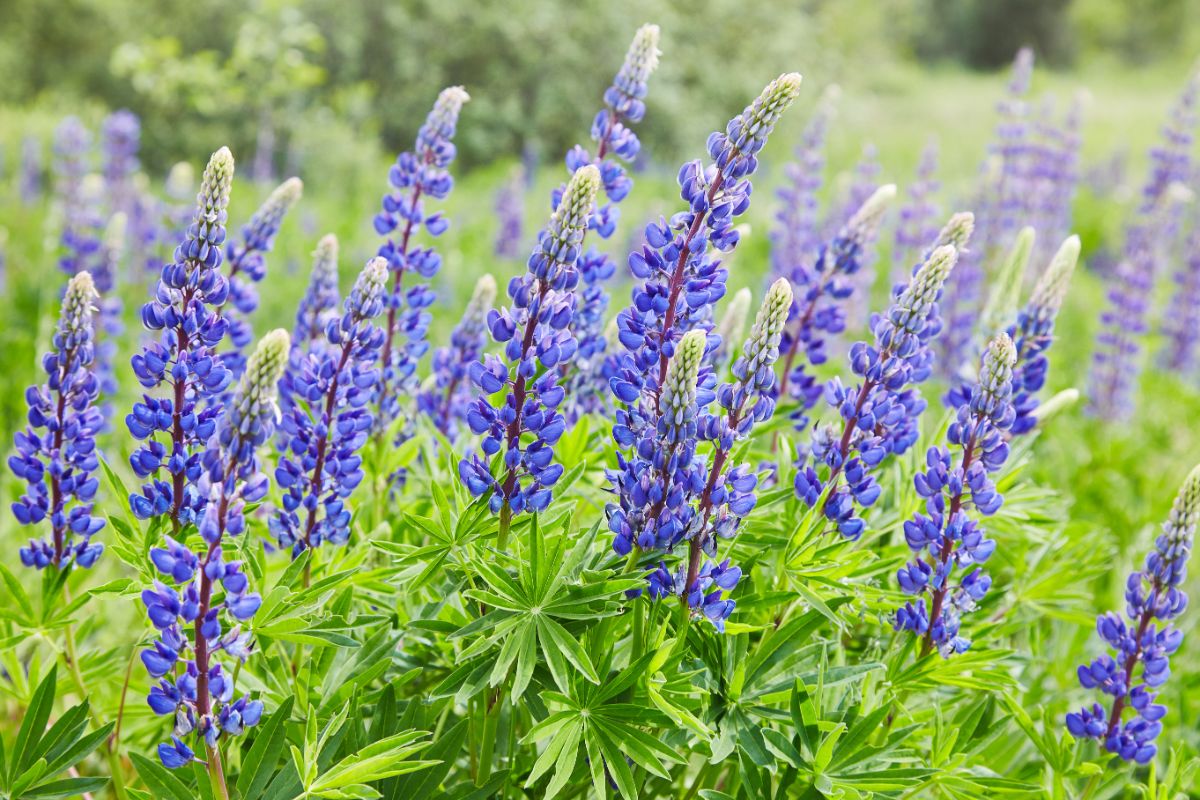
| Plant name: | Lupines |
| Light requirements: | Full sun |
| Water requirements: | Moderate to low |
| Growing zone: | Zones 4 to 8 |
| Special features: | Spring bloomer; Improves soil |
Lupines bloom in late spring, and when they do, they produce a colorful display of flowers that will liven up any garden. Lupine flowers form in tall, vertical spires, and flowers come in pinks, purples, and white. Beneath the flowers, lupines have unique, whorled leaves that will also add texture and movement to garden beds.
Lupines are actually members of the legume family, which means they can improve your garden soil over time. Like other nitrogen-fixing plants, lupines draw nitrogen from the air and lock it into the earth, which makes it more accessible for other plants to absorb. That’s why plants that grow near lupines often have fuller leaves and more abundant flowers.
10. Peony (Paeonia lactiflora)
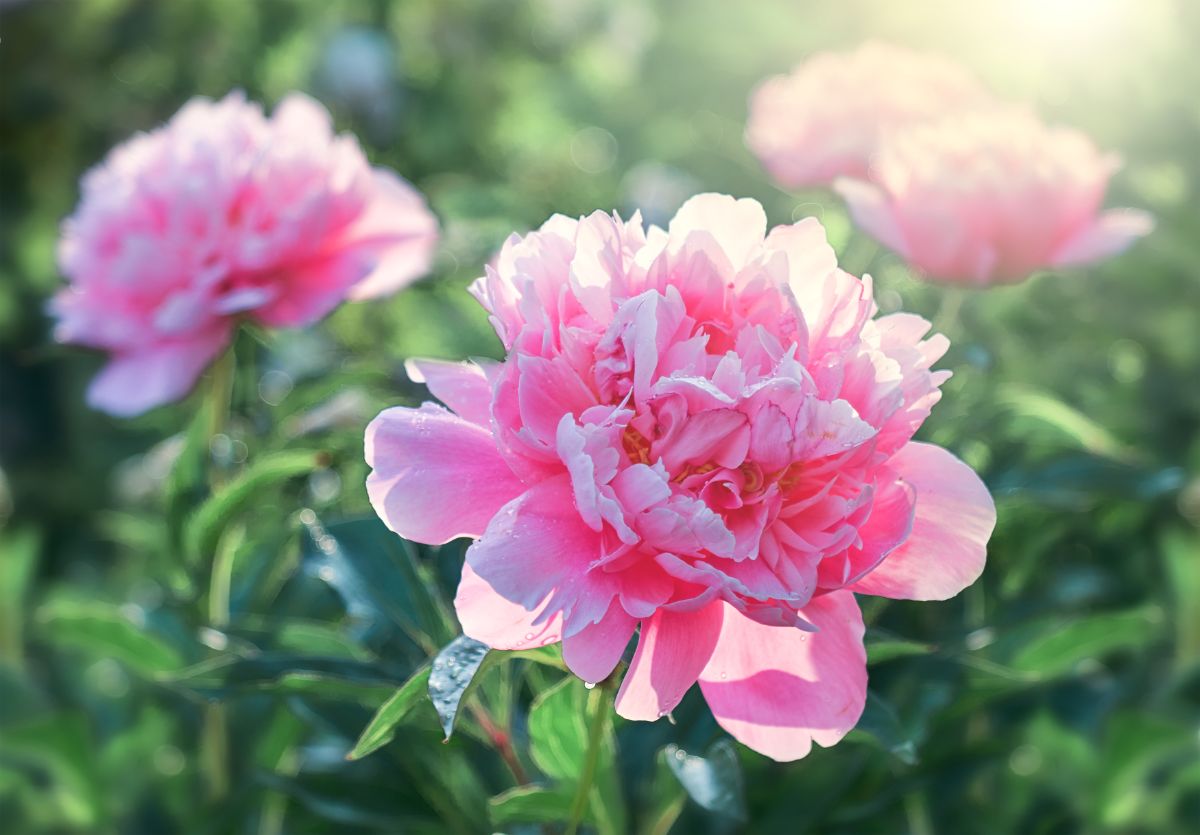
| Plant name: | Peony |
| Light requirements: | Full sun |
| Water requirements: | Moderate |
| Growing zone: | Zones 3 to 8 |
| Special features: | Fragrant flowers; Excellent cut flowers |
Peonies are exceptional garden plants, but they also work well in cut flower arrangements, so if you love making bouquets, you need to grow at least a few peonies! Peonies flower in late spring to early summer, and they’ll fill up your garden with bright colors and a heady, floral fragrance that can’t help but put a smile on your face. Most often, you’ll find peonies in various shades of pink and white, but you can also find red and yellow varieties.
Peonies are full sun plants, and they should be planted in an area of your garden that receives at least 6 hours of bright light daily. Additionally, since these plants get a bit top-heavy when in bloom, you may want to stake them up with bamboo poles or tomato cages. It’s also a good idea to always keep peony leaves dry and only water your plants at the base, which will prevent issues with mildew.
11. Sweet peas (Lathyrus odoratus)
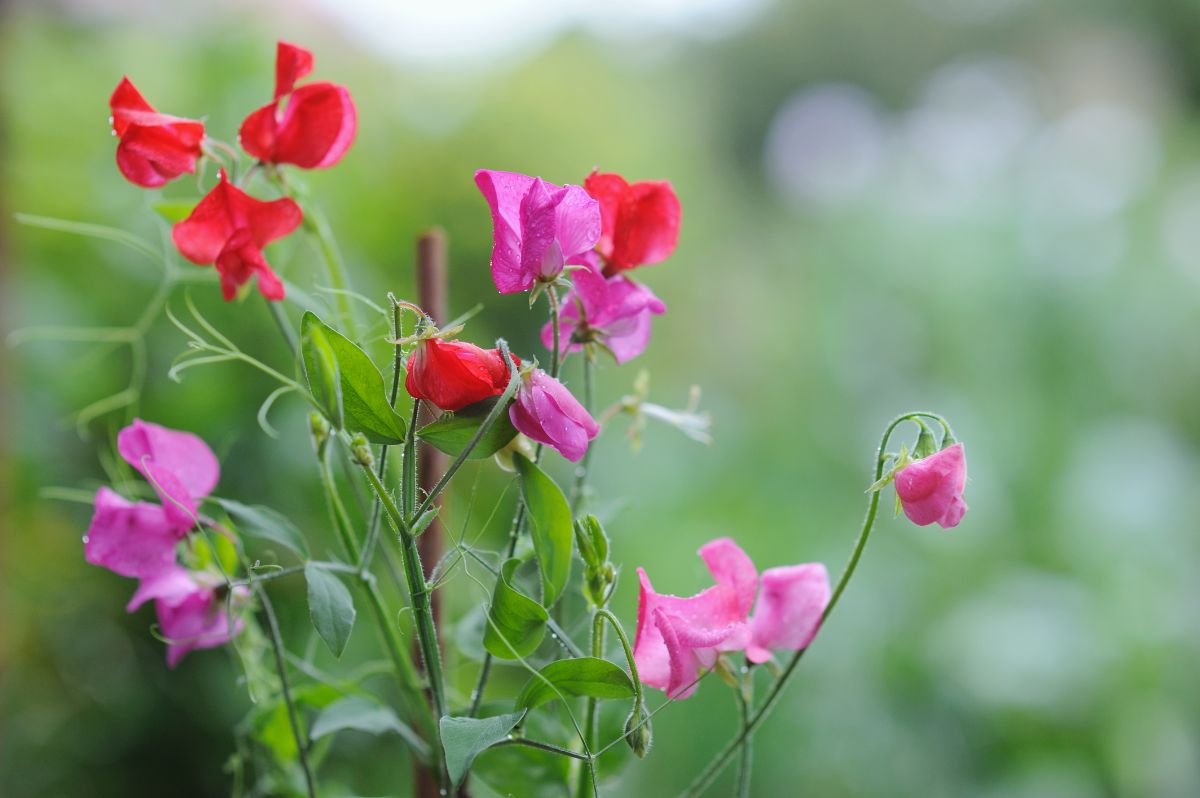
| Plant name: | Sweet peas |
| Light requirements: | Full sun, may benefit from afternoon shade in very hot locations |
| Water requirements: | High |
| Growing zone: | Zones 2 to 11 |
| Special features: | Spring bloomer; Climbing vines can be trained on trellises and fencing |
Darling and dainty, sweet peas are climbing plants that can be trained to grow along trellises or fencing, and they will also dutifully clamber over porch railings too. When they bloom in spring, sweet peas are sure to delight you with their richly colored petals in pinks, purples, and other pastel hues. Flowers also emit a sweet fragrance that has notes of citrus and rose and is positively bewitching when it blows in through an open screen door!
Sweet peas don’t handle heat well, but they will grow quite happily in spring and fall gardens. If you’d like to keep sweet peas in your autumn garden, sow seeds in mid-summer to early fall in temperate locations. Despite their name, sweet peas are not closely related to shelling peas, and they are not edible.
12. Coneflowers (Echinacea spp.)
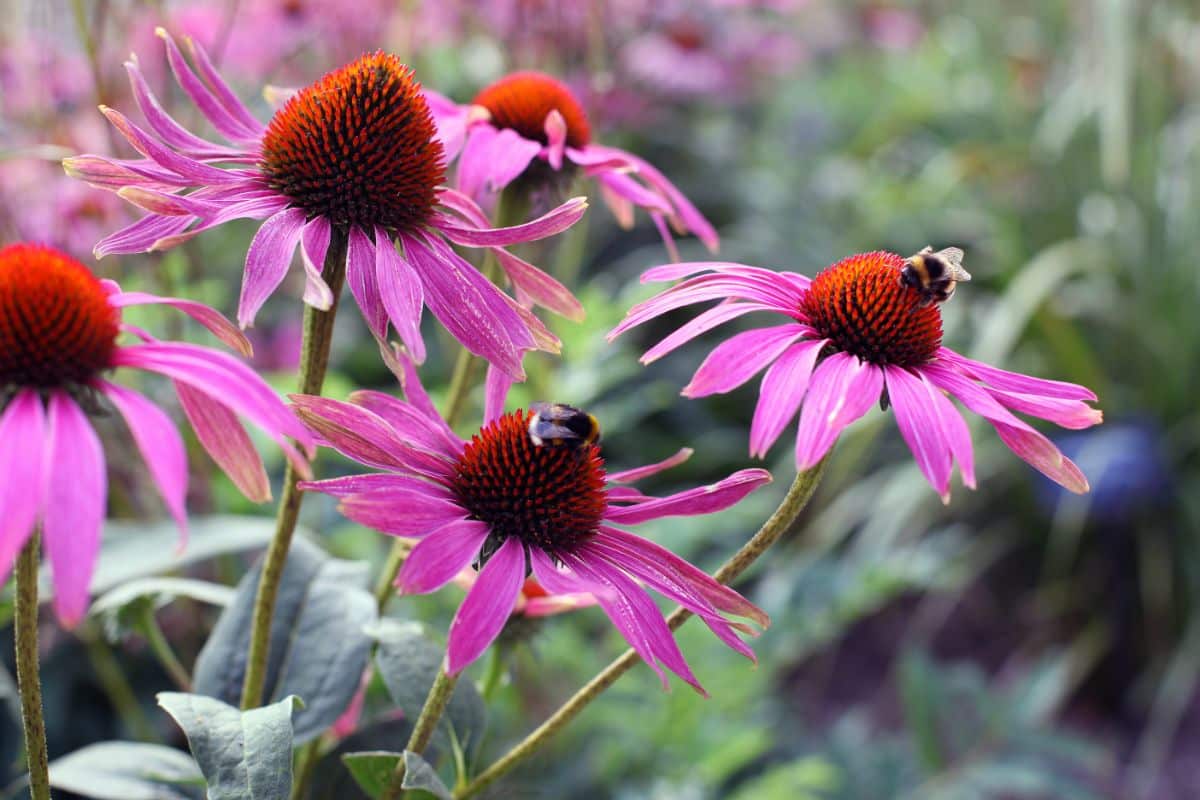
| Plant name: | Coneflowers |
| Light requirements: | Full sun |
| Water requirements: | Moderate to low |
| Growing zone: | Zones 3 to 8, depending on variety |
| Special features: | Excellent cut flowers; Drought tolerant; Attracts pollinators |
For a resilient plant that will bloom reliably in a range of soil types, coneflowers are hard to beat! Drought tolerant and adaptable, coneflowers rarely need extra attention once they become established in your garden, and they are the perfect “plant it and forget it” type of plant. If you’re just starting out with a new cottage garden, planting coneflowers can be a good idea because you can learn a lot about plant care from these hardy flowers.
Purple coneflowers (Echinacea purpurea) are one of the most commonly grown coneflower varieties, but you can find coneflowers with yellow, orange, and pink petals too. When in bloom, coneflowers are absolute magnets for a wide range of pollinators, including bees. Later in the season, coneflowers also produce large seed heads, which are a favorite food source for wild birds in winter.
13. Heartsease (Viola tricolor)
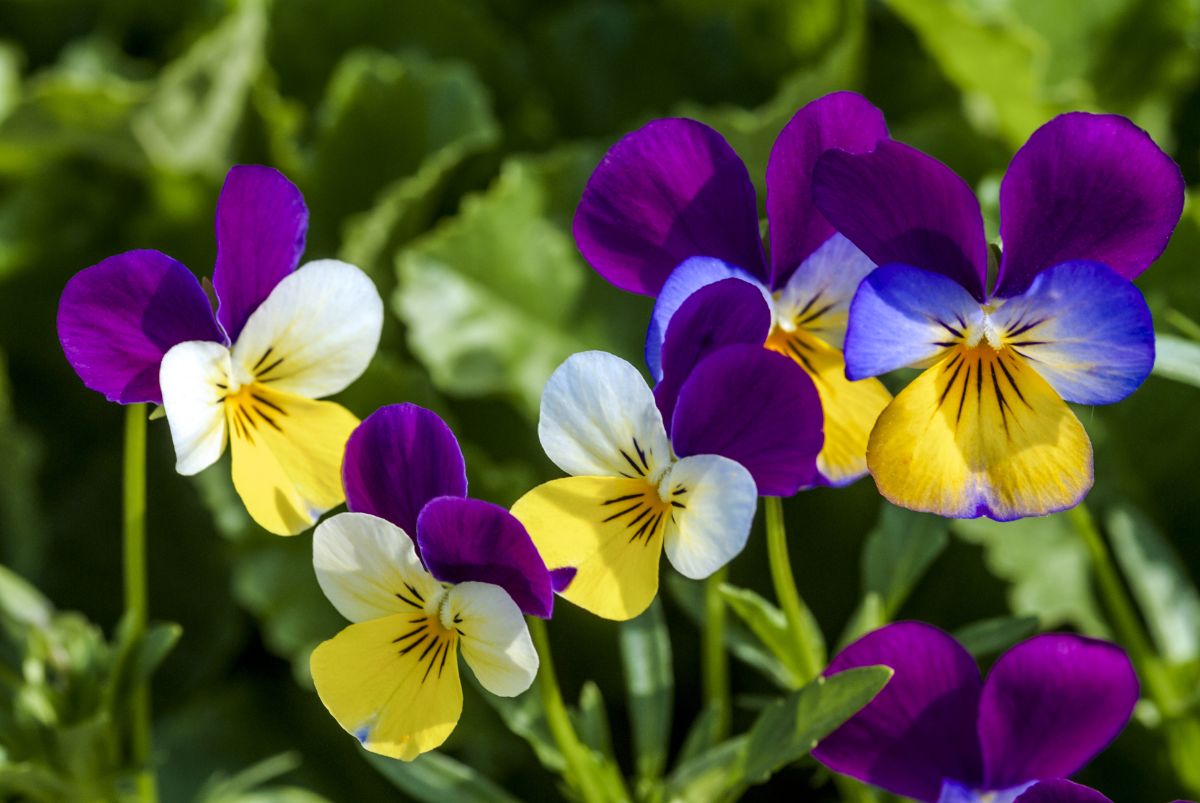
| Plant name: | Heartsease |
| Light requirements: | Full sun to part shade |
| Water requirements: | Moderate |
| Growing zone: | Zones 4 to 8 |
| Special features: | Good for containers; Great for crafting |
Also known as wild pansies or Johnny jump ups, heartsease are adorable little plants that will always gladden your heart! In cottage gardens, heartsease pair beautifully with peonies, snapdragons, and other ornamentals. They are also low-growing plants that work well when grown towards the front of garden beds, but they can also be used as colorful border plants, and they are small enough to keep in window boxes too!
Heartsease is easy to grow from seed, but you can usually find nursery starts for even earlier flowers. Flower petals are very colorful, with multiple shades of purple, yellow, and blue in a single flower. If you like pressing flowers, heartsease is one of the best plants you can grow because they preserve beautifully!
14. Snapdragons (Antirrhinum majus)
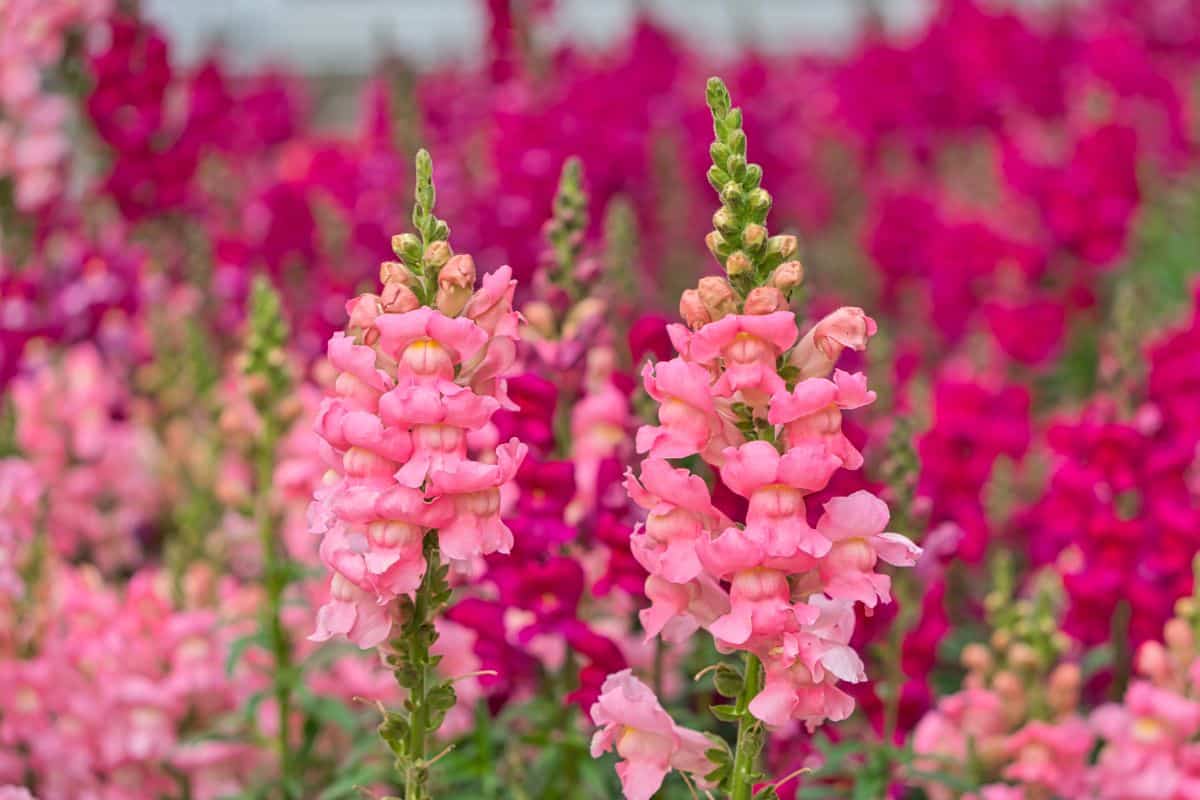
| Plant name: | Snapdragons |
| Light requirements: | Full sun to part shade |
| Water requirements: | Moderate |
| Growing zone: | Zones 7 to 11; can be grown as annual in cooler areas |
| Special features: | Excellent cut flowers; Good for containers |
Snapdragons are tender perennials that will only overwinter in zones 7 and up, but they can be kept as annuals in cooler locations. Named for their unique flower shapes that look a bit like a dragon’s face, snapdragons come in a wealth of colors, including salmon, yellow, and burgundy. In cottage gardens, you’ll create the most impact by planting an assortment of snapdragons together, but these pint-sized beauties also look impressive in window boxes and planters.
While snapdragons grow well in containers, they also make colorful border plants and can be used to soften the lines around walkways and other hardscape elements. If you like making homemade bouquets, snapdragons are a good candidate for flower arranging. Snapdragons prefer to grow in full sun, and they will produce more flowers in bright light, but they are adaptable enough for part shade gardens too.
15. Columbine (Aquilegia spp.)
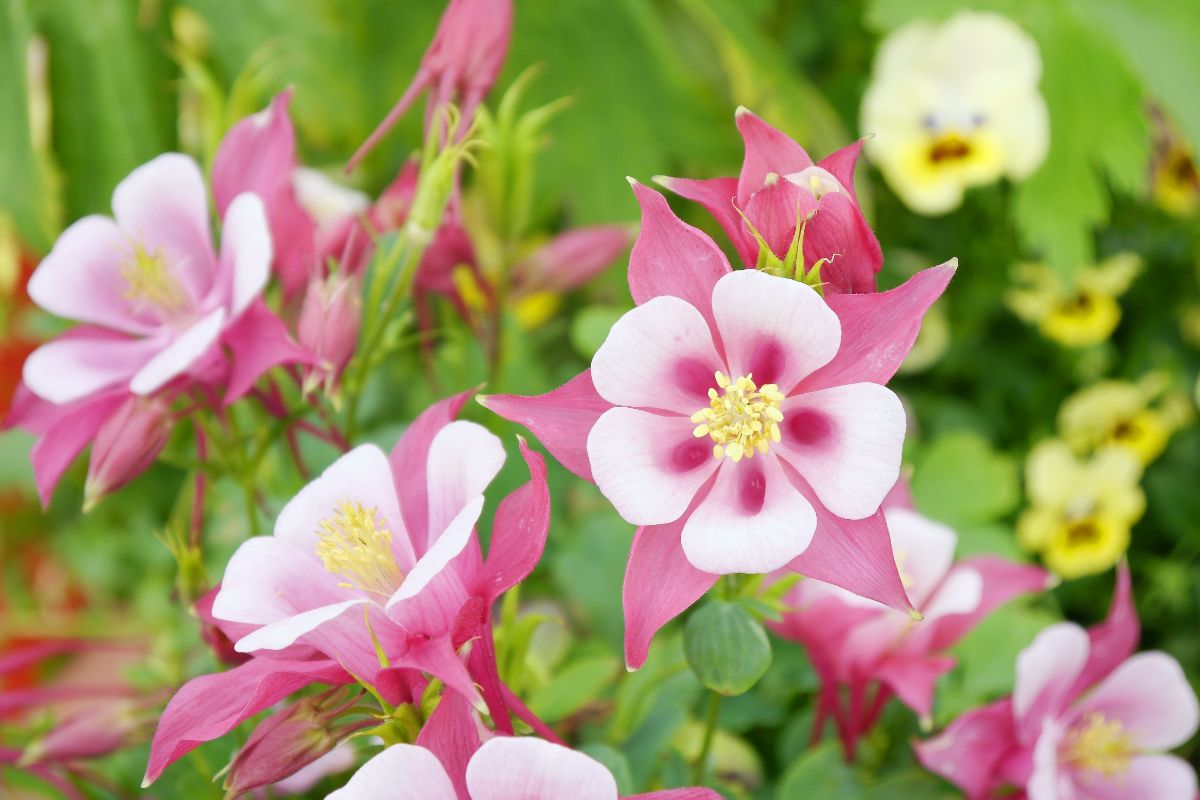
| Plant name: | Columbine |
| Light requirements: | Full sun to part shade |
| Water requirements: | Moderate |
| Growing zone: | Zones 3 to 9 |
| Special features: | Attracts pollinators |
There are about 70 different types of columbines today, which gives you a lot of flowers to pick from. Most columbines are well known for their colorful and uniquely shaped flowers that often feature pronounced spurs that are said to resemble the talons of an eagle. In fact, columbine’s Latin name means eagle, which is a reference to the flower’s form.
One popular type of columbine to grow is the eastern red columbine (Aquilegia canadensis), which is native to North America. This plant is a top hummingbird plant and will definitely draw an assortment of pollinators to your garden, although other columbines will attract pollinators too. Most species of columbines are naturally found in wooded areas and meadows, and they will appreciate a bit of dappled shade when grown in garden beds.
16. Hardy geranium (Geranium bohemicum)
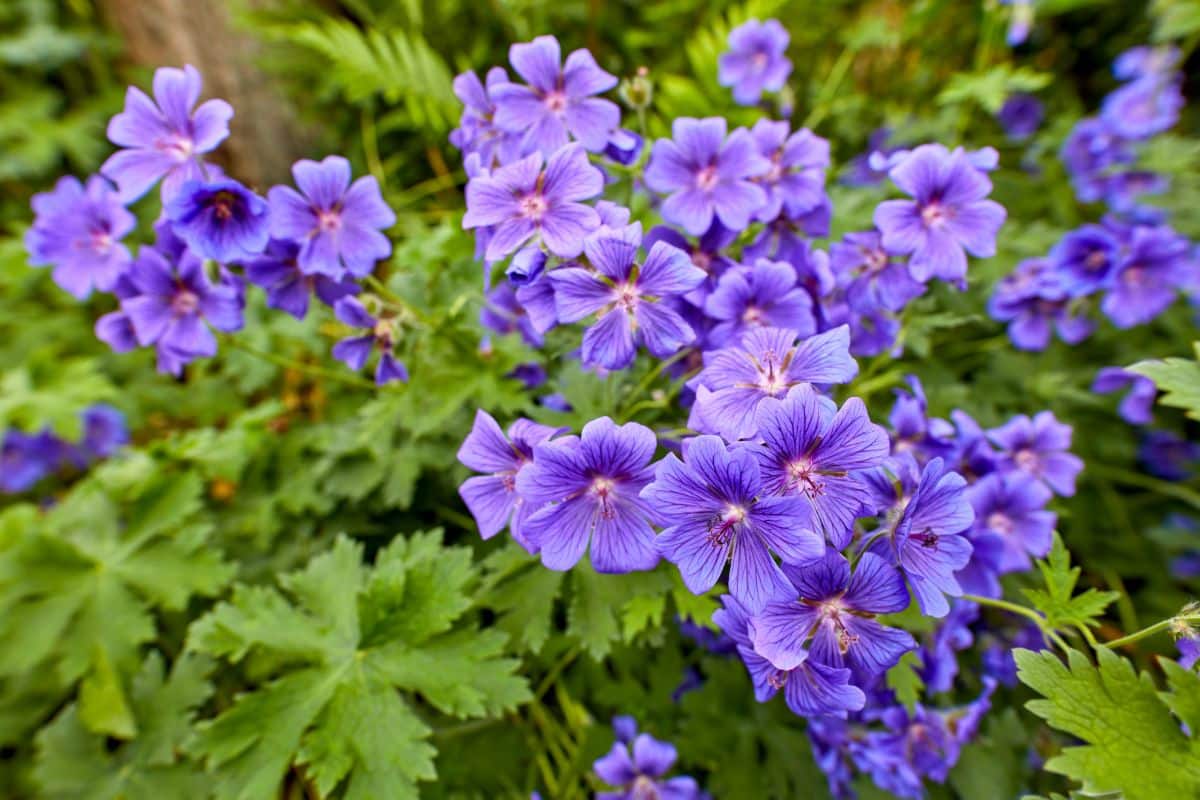
| Plant name: | Hardy geranium |
| Light requirements: | Full sun to part shade |
| Water requirements: | Moderate |
| Growing zone: | Zones 3 to 9 |
| Special features: | Attracts pollinators |
Also known as perennial geraniums or cranesbill geraniums, hardy geraniums will dazzle garden visitors when they bloom an abundance of brightly colored flowers from spring through fall. Flowers are delicate in form and feature vivid purple flowers that are veined with an even darker purple tone. Bees will flock to hardy geranium blooms, and their nectar is an important food source for butterflies too.
Hardy geraniums are native to Europe, and they aren’t as showy as some other geranium types, but that’s exactly what you want in a cottage garden. These plants will add subtle hints of color along walkways and in mixed beds, but they can also be kept in containers. Adaptable and resilient, hardy geraniums can grow in full sun or part shade, and they have minimal watering needs once established.
17. Honeysuckle (Lonicera spp.)

| Plant name: | Honeysuckle |
| Light requirements: | Full sun |
| Water requirements: | Moderate |
| Growing zone: | Zones 5 to 9 |
| Special features: | Attracts pollinators; Vines can add vertical interest; Fragrant flowers |
Some types of honeysuckle are invasive in certain areas, so it’s important to do a bit of research before selecting the right honeysuckle for your cottage garden. If possible, look for native honeysuckle types or select popular varieties like ‘Trumpet’ honeysuckle and ‘Coral’ honeysuckle. These plants have fabulously colorful blooms, and they will draw the eye when allowed to grow and twine over fence posts and garden archways.
Honeysuckle plants are famous for their sweetly scented flowers that smell like honey and become even more fragrant in warmer weather. Depending on the variety of honeysuckle you grow, you can enjoy flowers from spring through summer, and pollinators love these plants too. While honeysuckles are lovely ornamentals, they are also very functional, and they can be used to conceal unsightly utility boxes and other parts of your garden that aren’t as aesthetically pleasing.
18. Mock orange (Philadelphus coronarius)
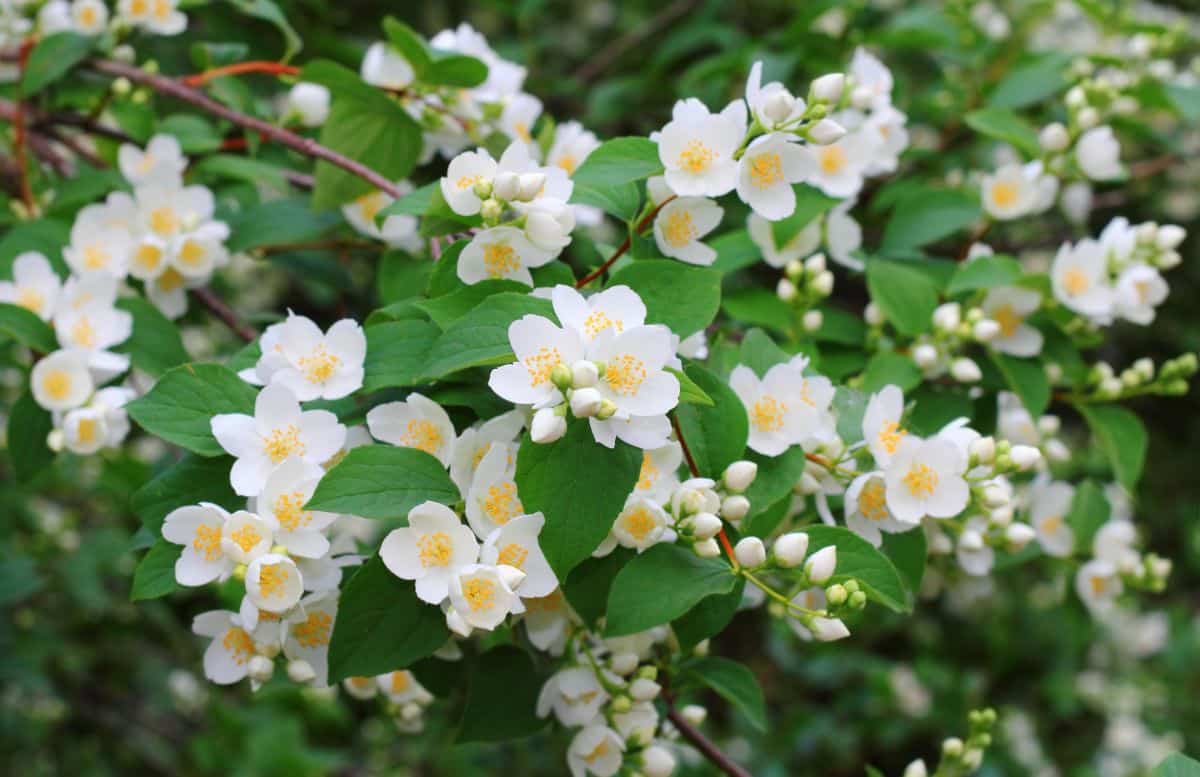
| Plant name: | Mock orange |
| Light requirements: | Full sun to part shade |
| Water requirements: | Moderate |
| Growing zone: | Zones 4 to 8 |
| Special features: | Fragrant flowers |
A fast-growing, deciduous shrub, mock oranges can grow up to 2’ per year, and they can stretch over 10’ tall. This makes them a good choice for adding extra garden privacy; however, they also make wonderful backdrop plants for garden beds, and they look beautiful when grown on their own too. While you’ll love mock orange’s rich green leaves, the true star of the show is this plant’s showy, white flowers that are richly aromatic.
Mock orange flowers emit a citrus-like scent that will enliven your garden beds. Flowers can bloom through spring and well into summer, and these plants can tolerate both sun and part shade. Like other shrubs, mock orange bushes should be planted in autumn to give their roots plenty of time to acclimate to your garden before the spring growing season.
19. Lady’s mantle (Alchemilla mollis)
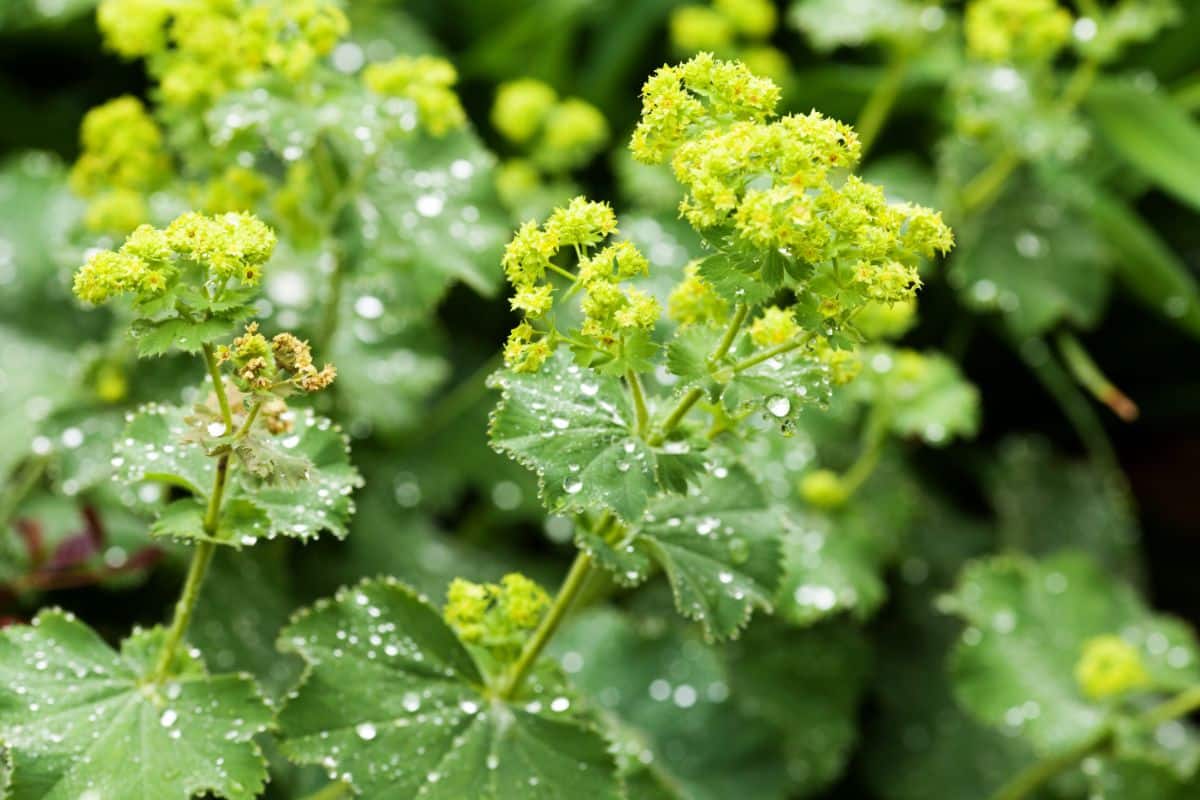
| Plant name: | Lady’s mantle |
| Light requirements: | Full sun to part shade |
| Water requirements: | Moderate to low |
| Growing zone: | Zones 3 to 8 |
| Special features: | Attracts pollinators |
Lady’s mantle is mostly kept as a foliage plant, although it does produce small, yellow flowers from late spring to early summer. The leaves of this plant are broad and flat and have the interesting habit of collecting droplets of dew in the morning. In fact, alchemists used the water gathered from lady’s mantle leaves in their ongoing hunt for the philosopher’s stone, which is where this plant got its Latin name!
Lady’s mantle is a subtle plant but that is part of its charm. Plant lady’s mantle as a border plant or in ornamental beds, as it will grow happily in a range of conditions. Mature plants form a wonderfully mounded growth habit, and they pair nicely with many other cottage garden plants, including sweet peas and snapdragons.
Summary
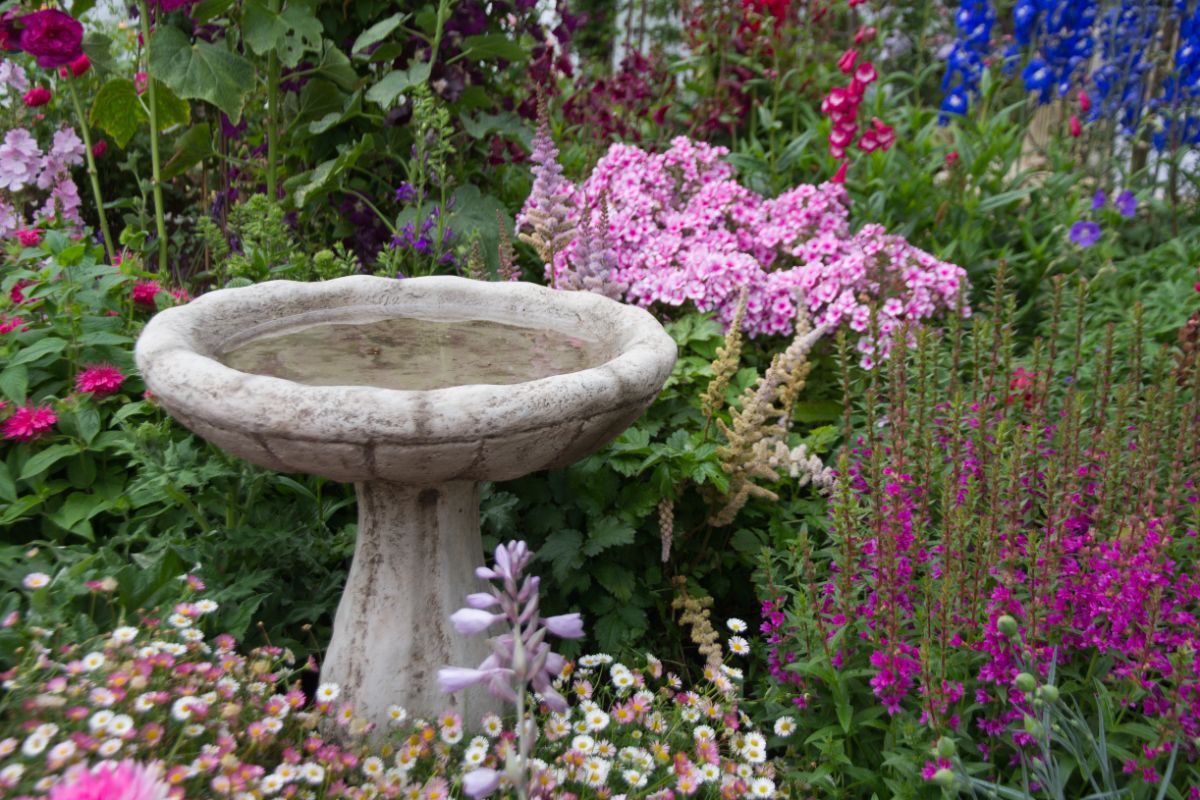
Cottage gardens have that perfect balance of whimsy and charm. Bursting with flowers in an assortment of shapes and colors, the mixed nature of these landscapes makes them feel a bit wild and otherworldly as if they could transport you into a fairytale of your own making!
While choosing the right plants for your cottage garden is one important step towards creating your own personal garden oasis, cottage gardens often feature other elements that should be considered too. From walkways and trellising to garden arches and stone benches, there are so many fun details to include in your cottage garden that you can’t help but be inspired.
To help you grow cottage garden plants successfully, you may want to explore our beginner-friendly guides on some of our favorite flowers, including lupines and hydrangeas.


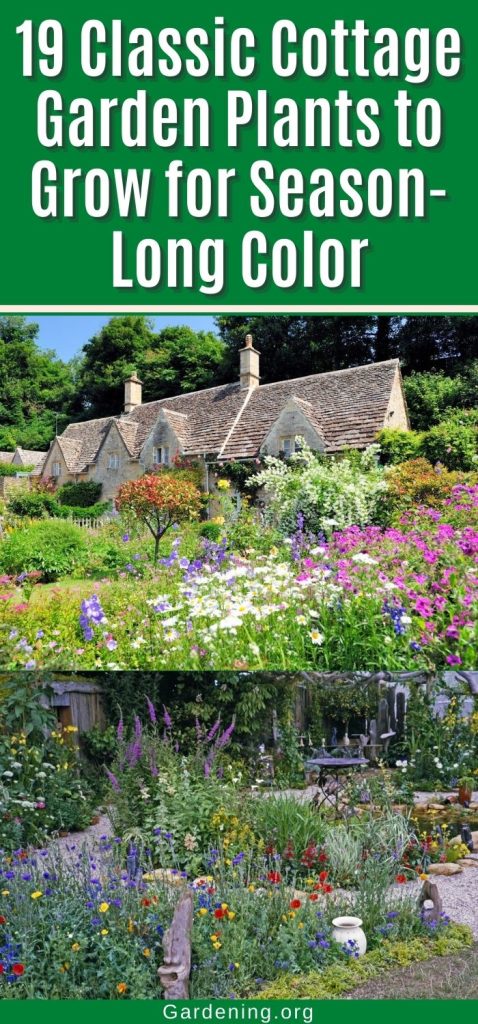
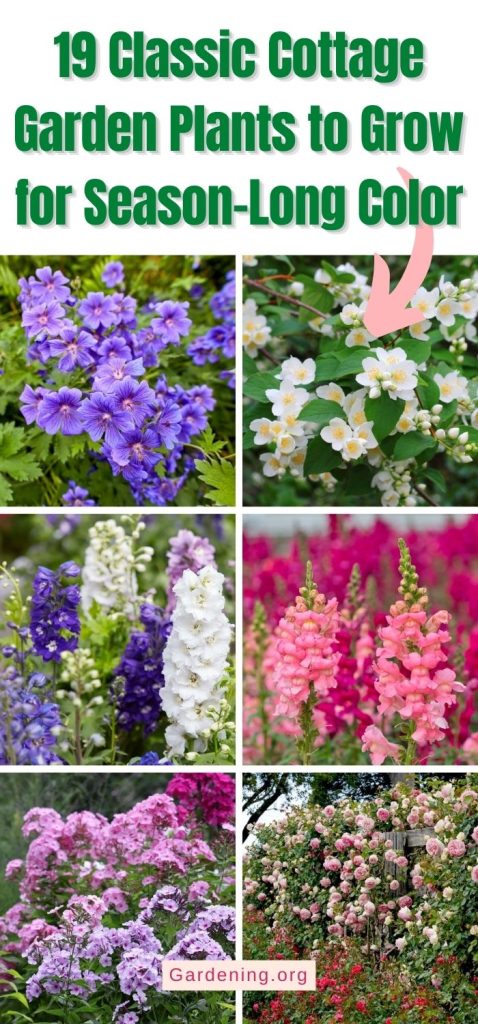
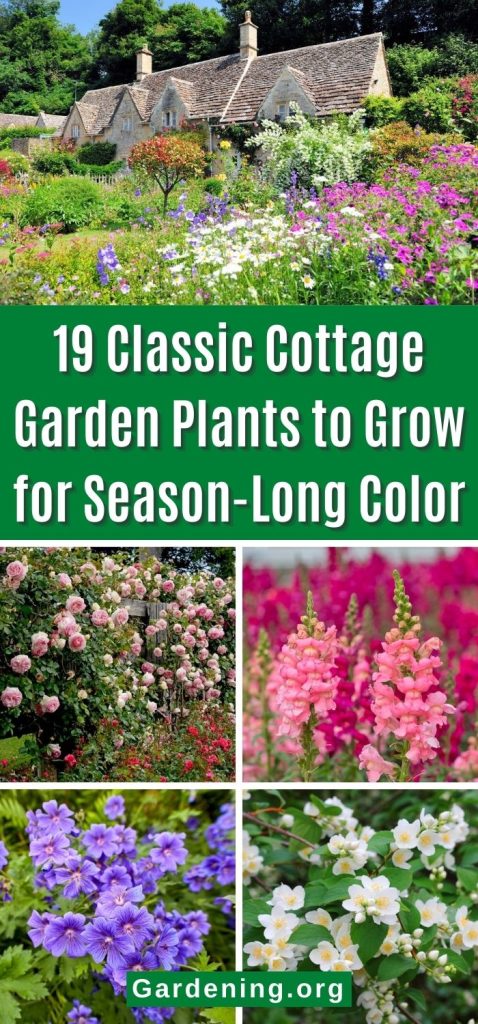

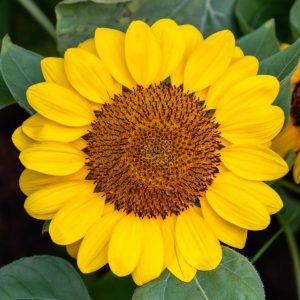
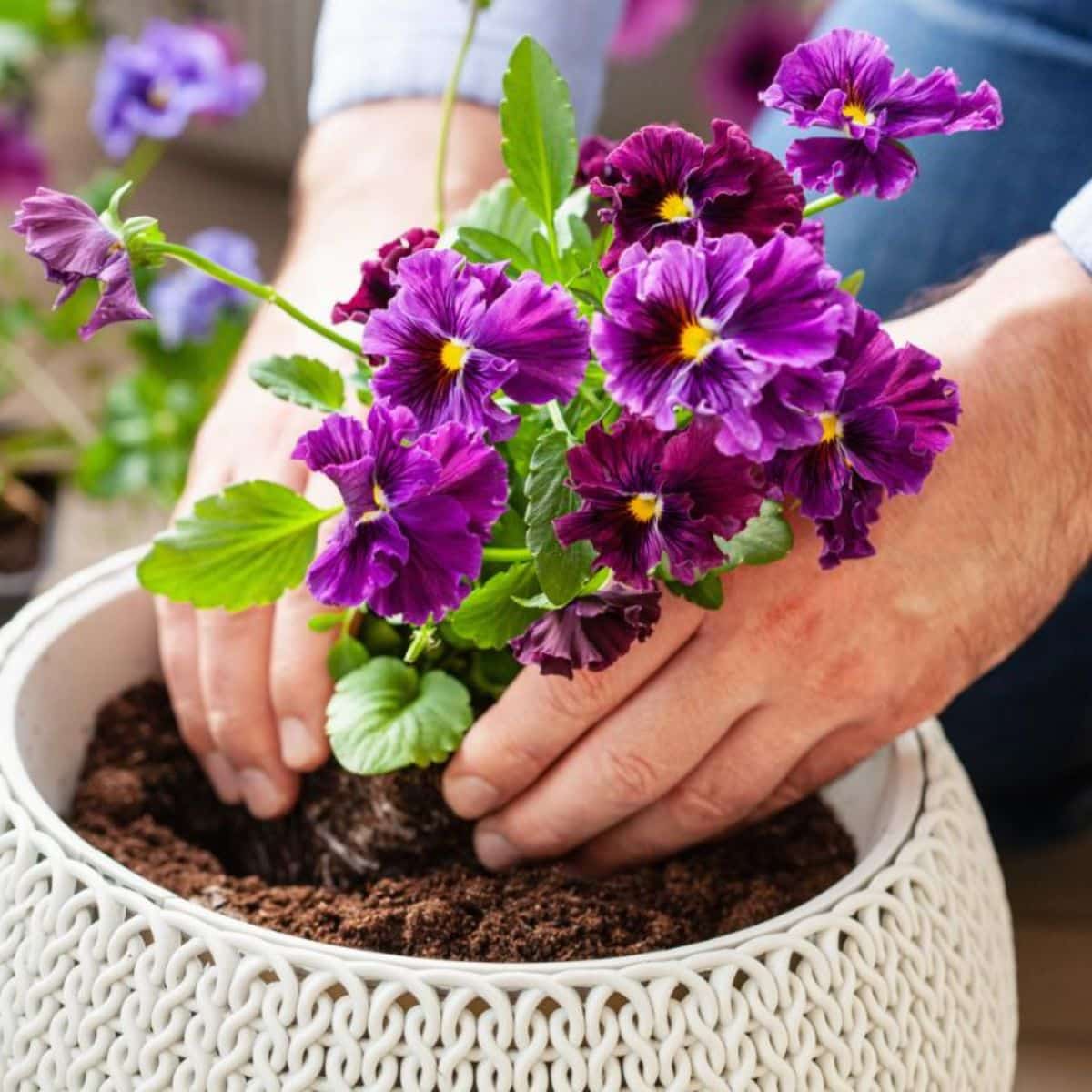
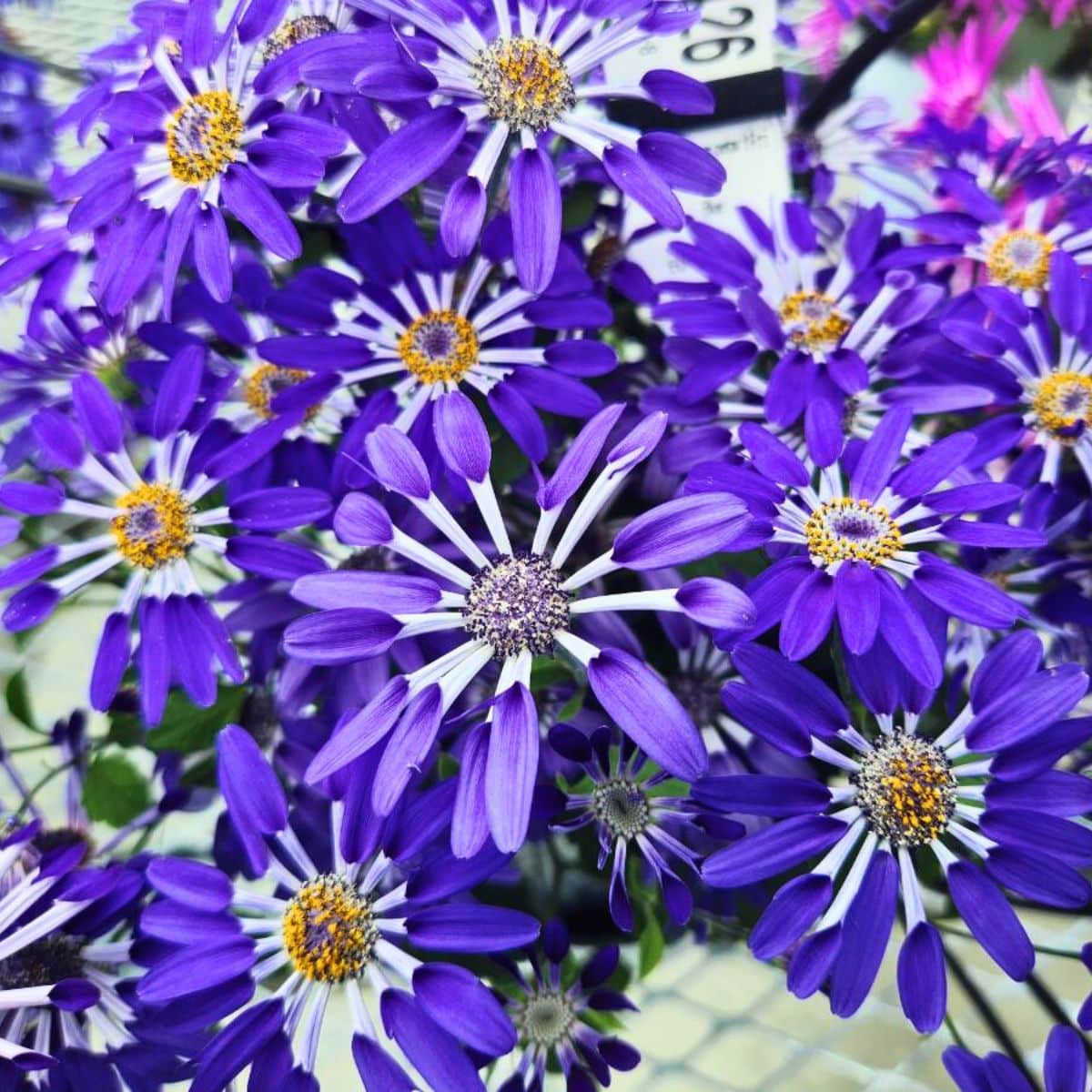
Susie Waggener
Thank you for all this vital information for the cottage garden! As a beginner, many failed attempts discouraged me but now I can get a handle on things with this information.